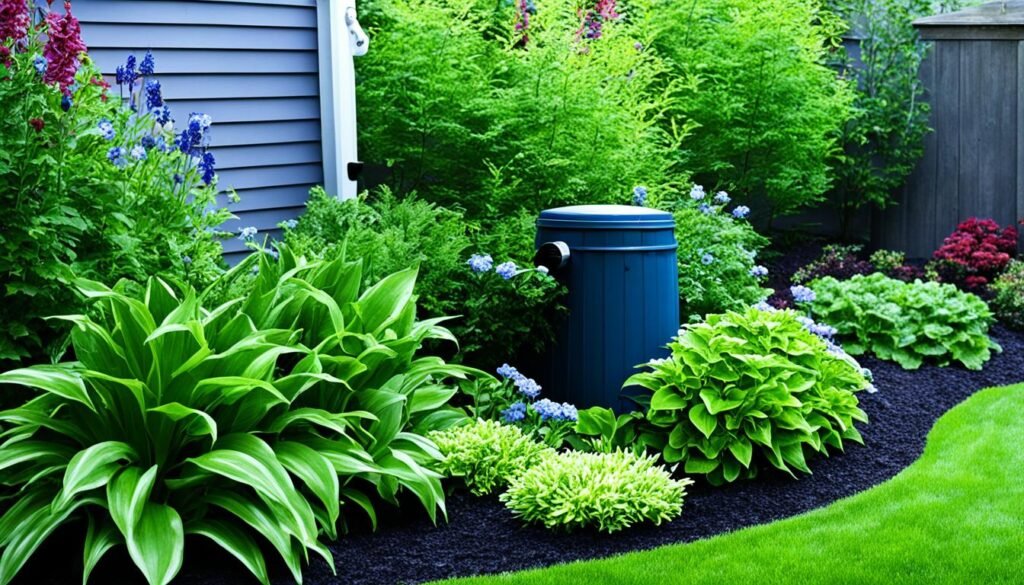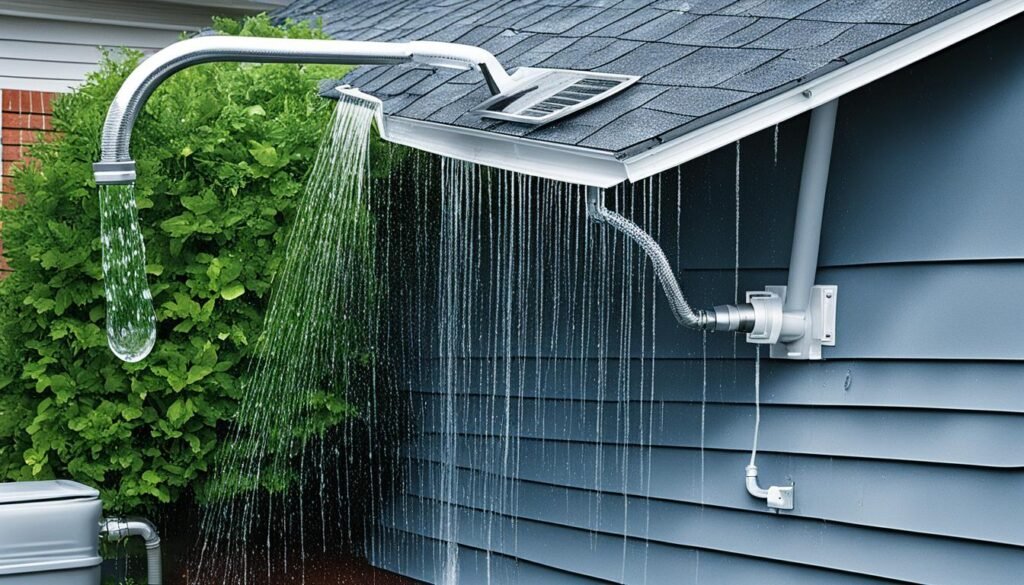Did you know water damage is the second most common homeowners claim? It’s right behind wind and hail damage. This fact shows how much impact water damage can have on your home and wallet. It can come from burst pipes, leaking appliances, or severe storms. Water damage is a risk all year. It can cause a lot of harm and lead to costly repairs.
But there’s no need to worry. You can take steps to protect your home from water damage. In this section, we share nine simple tips every homeowner should know. By using these strategies, you can keep your home safe. You’ll also lower the risk of water-related disasters striking your home.
Key Takeaways:
- Disconnect hoses in the fall to prevent frozen pipes.
- Clean gutters and downspouts regularly to stop blockage and ice dams.
- Keep trees and vegetation in check to prevent root damage to pipes.
- Learn where the water main shutoff is for fast action in emergencies.
- Check appliances often for leaks and replace old hoses as needed.
Tips for Preventing Water Damage Inside the Home
In this section, you will learn easy steps to prevent water damage from sources inside your home. By following these tips, you can reduce the risk of costly damage. This helps maintain the integrity of your property.
1. Know the Location of the Water Main Shutoff
Being aware of the water main shutoff valve in your home is crucial in case of emergencies. Familiarize yourself with its location. Make sure you can easily access it if needed.
2. Maintain Appliances
Regularly checking your appliances for leaks and replacing old hoses can help prevent water damage. Consider installing stainless steel braided hoses. They are more durable and less prone to leaks compared to rubber hoses.
3. Investigate and Fix Leaks Promptly
Addressing leaks promptly is essential to prevent further damage. This includes mold growth and structural issues. Regularly inspect your plumbing system. Promptly fix any leaks you find.
4. Install Water Detection Devices
Installing water detection devices near potential sources of leaks can provide early warnings. They help you take immediate action to prevent water damage. Place them near washing machines, water heaters, and sinks.
5. Check Water Pressure
High water pressure can strain your pipes and hoses, increasing the risk of leaks and bursts. Use a pressure gauge to regularly check your water pressure. Ensure it is within the recommended range.
6. Monitor Water Bills
Keep an eye on your water bills for sudden increases that can indicate a hidden leak. If you notice a significant rise in water usage, investigate the cause. Then, take appropriate measures to fix the issue.
By implementing these easy steps to prevent water damage inside your home, you can safeguard your property. You’ll avoid the hassle and expense of water-related issues. Remember, prevention is key to maintaining your home’s value and integrity.
Tips for Preventing Water Damage Outside the Home
Protecting your home from water damage isn’t just an inside job. It’s crucial to also focus on prevention outside. By taking a few simple steps, you can keep your property safe from water’s harm.
Disconnect Hoses in the Fall
When it gets cold, remember to detach your hoses from the faucets. If water in the hoses freezes, it can make pipes burst. This causes serious damage. To avoid this, disconnect hoses and empty them of water. This reduces the risk of your pipes freezing and damaging your home.
Clean Gutters and Downspouts Regularly
Keeping your gutters and downspouts clear is key for water to flow properly. If they’re clogged, water overflows and gathers by your home’s foundation. This can lead to major damage and even affect your home’s structure. Clean out any debris to ensure water can run freely and prevent issues.
Maintain Trees and Vegetation
Maintaining your property’s greenery is important to prevent pipe damage. Tree roots can grow into pipes, causing leaks and water damage. Trim branches and keep plants away from water pipes to avoid this problem.
Follow Sewer-Safe Landscaping Practices
Plan your landscaping with your sewer lines in mind. Don’t plant trees or shrubs too close to them to prevent root damage. Also, make sure water drains away from your house properly. These steps can greatly lower your water damage risk.
With these practices, you can keep the outside of your home safe from water damage. Being proactive is key. It preserves your home’s condition and saves you from costly repairs.
| Preventive Measure | Description |
|---|---|
| Disconnect Hoses | Disconnect hoses from outdoor faucets in the fall to prevent frozen pipes and potential water damage. |
| Clean Gutters and Downspouts | Regularly clean gutters and downspouts to prevent blockage, water overflow, and potential structural damage. |
| Maintain Trees and Vegetation | Maintain trees and vegetation around your property to avoid root damage to water pipes and prevent leaks. |
| Follow Sewer-Safe Landscaping Practices | Adopt sewer-safe landscaping practices, such as avoiding planting near sewer lines, to prevent root intrusion and water damage. |

Conclusion
Water damage can hit hard, but you can fight back with the right steps. By using these tips, you keep your home safe and cut down on repair bills. It’s crucial to act early and fix any water troubles to avoid bigger problems.
To keep water damage at bay, start with simple things. Unhook hoses, clean your gutters, and trim trees near your home. Also, make sure you know how to turn off your water main. Taking care of your appliances helps too.
Don’t let leaks linger; fix them fast. Installing devices to detect water helps catch issues early on. Also, check your water pressure and keep an eye on your water bills for unusual spikes.
Keeping water damage away means keeping your home’s value high and its structure solid. Follow these strategies to make sure your home stays safe and strong. Be proactive and vigilant—this is the key to protecting your place against water damage.


